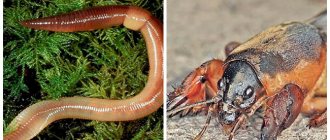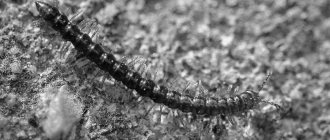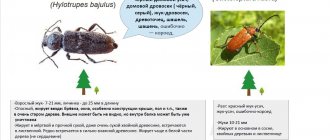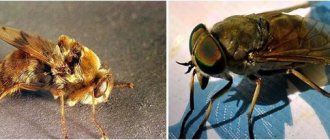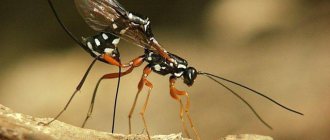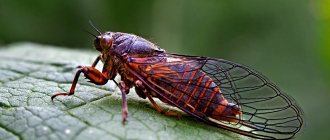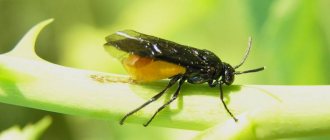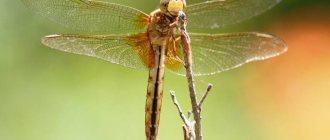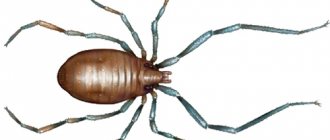What does a bear look like?
The insect belongs to the class of large invertebrate arthropods from the order of jumping neoptera. A sexually mature individual grows up to 7.5 cm and lives in burrows, which it digs itself. The front pair of limbs, which outwardly resemble ticks, helps her in this. In addition to spikes designed to loosen the earth, the legs have auditory openings. The other two limbs, the hind ones, help in movement; on the inside of them there are several sharp growths.
The insect has an abdomen, which is several times larger in size than the cephalothorax and reaches a thickness of about 1.4 cm. The upper part is covered with a hard shell, in which the head can partially hide. The mouth contains two powerful jaws designed to chew roots.
The mole cricket has several pairs of wings, the front ones being small and reaching only to the middle of the abdomen, but the other two are long and transparent with thin veins. With their help she flies.
Why is the mole cricket called that?
The insect got its name due to its brown color and dark brown small hairs covering the body, large size and sharp black claws, which are located on the front legs. It looks quite scary. Other nicknames include the following:
- Kapustyanka - this name was given to her because she loves to eat the leaves of young cabbage heads, potato tubers and beets.
- Mole cricket - for its resemblance to an insect from the same family of jumping Orthoptera, which can make sounds by rubbing its elytra, and to an animal that digs its own holes and has strong front legs.
- Earthen crayfish - for its hard chitinous shell and claw-like paws.
And also, sometimes, you can hear the nickname “top” - this is because young individuals have a gray color and pointed spines on their limbs.
Is it dangerous for humans?
Seeing a mole cricket, everyone will be afraid of how unattractive she is. But the pest is not poisonous and does not pose a danger to humans. Some gardeners claim that these insects bite. But even adults can only pinch lightly with their front paws. Sometimes the bite is painful, but this sensation quickly passes without a trace.
Although the mole cricket is not poisonous, it does a lot of harm due to its lifestyle. This insect is dangerous to plants and crops. But there are many ways to get rid of it, and any gardener will always choose the one that is suitable in each individual case. And if events are held in a complex, and even together with neighbors, the pest is forgotten forever.
Distribution and habitat
The habitat where representatives of this type of pest are found covers a very large territory: Western Europe, except for cold countries such as Norway, Asia - Central and Southeast, Transcaucasia and North African countries - Egypt, Morocco, Libya and others. In Russia, the insect is distributed everywhere - from St. Petersburg to Crimea.
The mole cricket does not like hot and dry places, so they live in the part where there is moisture, that is, near reservoirs in sandy or clay soils. The most preferable place for them is a place rich in humus, so very often the insect lives in vegetable gardens, orchards and flower beds. They love wetlands and areas with groundwater.
First, the pest settles in damp and well-manured areas of the garden, and later, if it is not destroyed, it will spread to other areas.
Types of mole crickets
There are several different species that practically do not differ from each other: they have the same lifestyle, taste preferences and appearance. The difference can only be noticed if you examine their chromosome set. There are about 110 species in total, among the known ones are the following:
- The common one is one of the largest groups that is widespread in Europe. Damages all types of grains and agricultural crops.
- African - grows up to 3.5 cm, body color is dark yellow, closer to brown. The abdomen is light yellow. It has small thread-like antennae.
- Ten-fingered - the species is widely represented in the USA and Canada. The size is from 2 to 3.5 cm. In its natural habitat it has an enemy - the ground wasp, it penetrates the mink and paralyzes with its sting.
- The Far Eastern mole cricket is morphologically close to the common mole cricket and is distributed in China, Vietnam, Japan and the Sakhalin region.
- Single-spike - differs from other species in that the thickness of its body is narrower, and the front wings have not very pronounced transverse veins. The length of a mature individual reaches 4.5 cm.
And the steppe mole cricket, which lives in the south of Russia, Ukraine and a number of other countries, is also quite famous.
What does a mole cricket eat and what causes damage to the garden?
The insect is the most common pest of fruits and vegetables; they damage the root system and the entire underground part of plants: tubers, root necks and even just sown seeds. They also harm seedlings of ornamental and berry crops planted both in open ground and in greenhouses. Very often the pest destroys the following species:
- new potatoes;
- fodder and sugar beets;
- carrot;
- white cabbage;
- tomatoes;
- bell pepper;
- beans;
- radish;
- pumpkin;
- poppy.
Cabbage weed also harms melons and melons: watermelons and melons. He also likes to eat young shoots of sunflower, hemp and tobacco. All grain crops suffer from it: wheat, oats, barley and rye. In the southern regions, the mole cricket damages citrus fruits, peanuts and tea.
In addition to plants, it also eats the larvae of insects living underground, as well as earthworms.
Lifestyle of a bear
Insects are one of the most ancient species that appeared on our planet, their remains are found everywhere and they date back millions of years. This species is very tenacious and can quickly adapt to the changing conditions of the environment where they live.
As a rule, the pest is nocturnal and does not appear on the surface during the day; it spends most of the day underground. All day long the mole cricket digs in the soil, making passages and eating everything that gets in its way. Insects make sounds even while underground, thus they give a signal to their own kind.
Their passages are located at a depth of 15-20 cm and consist of numerous holes in which they do not spend more than a few days. The network of branches dug by cabbageweed can reach great distances; they move all the time, destroying crops with their powerful jaws.
Scientists have found that their chirping is many times louder than that of grasshoppers or crickets. The human ear is able to detect these sounds from a distance of more than 500 m, but only in the evening. During the day they are practically inaudible, probably due to the fact that they are afraid of being discovered.
At night, they crawl to the surface of the earth in order to find a new area where there is food. If necessary, insects can travel long distances - they fly and swim well.
Description of the insect
The shell and head of a mole cricket
Mole cricket is a major soil pest . These insects appeared on Earth before humans. This is confirmed by the found remains of the Cretaceous period.
The insect is popularly called earthen crayfish because of its appearance. On average, the length of an adult is 5–8 cm, but there are giants up to 10–15 cm in size. The mole cricket’s abdomen is soft, long, spindle-shaped with a diameter of up to 1 cm. It is colored light brown or olive. The chest is protected by a powerful shiny carapace of dark brown or brown color. In case of danger, the insect's head can partially hide under the hard chest shell.
The pest has 2 large compound eyes, long mustaches and strong jaws for gnawing stems, roots, destroying tubers, bulbs and root crops. With its front flat and jagged limbs, resembling claws, the mole cricket digs passages and holes in the soil.
The pest is shy, rarely comes to the surface, mainly at night, and during the day prefers an underground lifestyle . The mole cricket can swim and fly. The insect can rise to a height of 0.5–5 m, some species cover greater distances - up to 8 km. To do this, the adult mole cricket has shortened elytra, under which are the hind wings, folded into flagella. Moves in the dark, only at high air temperatures. When it is cold, the insect's muscles do not warm up to the required temperature.
There are 3 types of pests common in our country. The common mole cricket is found everywhere in the European part of the country; the single-spined species lives in the Volga region, and the eastern species lives in the Far East.
Reproduction of mole crickets
After a long winter, when the ground warms up well and the air temperature does not drop below +10 degrees, sexually mature individuals crawl to the surface en masse, looking for a mate for mating. The process itself takes place underground and, upon completion, the female begins to arrange a place where she will lay eggs. Around the roots of plants, the insect digs several tunnels, where it arranges small rounded nests, which are 8-10 cm wide. Both parents are engaged in construction, then the female lays from 300 to 500 eggs.
Next, the most crucial period begins, because in order for the offspring to be viable, they need the creation of certain conditions. The female is always close to the clutch; she not only protects the future offspring, but also maintains the necessary humidity and temperature.
The timing of the appearance of the larvae depends on how well the soil has warmed up; approximately two weeks should pass, and then gray nymphs will appear. They do not yet have wings and will remain in their burrow near their mother for about a month. After the offspring becomes independent, the female dies, and the larvae will develop for several more years until they fully mature. During this period they will shed 8-10 times.
Development cycle
The stages of development of the mole cricket are as follows:
- Eggs.
- Larvae.
- Nymphs.
- Adults.
Second instar mole cricket larvae or nymphs are born in 14-20 days. These are miniature insects of a gray-white color, which in external structure practically do not differ from the adult individual. The only difference is the lack of wings.
Dug out nest with eggs
Mole cricket larvae
Mole cricket nymphs
After birth, mole crickets are blind for the entire period until the first molt , so they spend some time in the nest, where the mother creates all the conditions for their existence. After the first shedding of the chitinous layer, young mole crickets leave the nest, beginning to live independently.
The development cycle from nymph to adult occurs in stages and ranges from 18 to 24 months.
Read more about mole cricket larvae and what a gardener should know to prevent the insect from multiplying here.
Natural enemies of mole crickets
Like any other insect, mole crickets become prey to a variety of predators:
- Birds - these can be rooks, starlings, storks, hoopoes or crows.
- Insectivores - hedgehogs, lizards, moles and shrews.
- Arachnids - the wolf spider hunts for grown larvae, it waits until one of them appears not far from its burrow, then it pounces on it and eats it.
- Predatory insects - one of the representatives of this species is the beetle, which lives in Japan and China. The female finds mole cricket burrows and lays eggs there; when larvae emerge from them, they crawl inside and eat the offspring.
- Tailless amphibians - toads perfectly exterminate these agricultural pests.
Ants and ground beetles eat the larvae and destroy the eggs laid by the adults.
Bacteria and parasites also play an important role in the destruction of cabbage mushrooms; they enter their body, which leads to the spread of infection and the death of the insect.
Fungal diseases that attack the insect during winter cold and thaw periods are also dangerous for them. Pathogenic microorganisms can cause the death of an entire population.
Benefit
This is truly an unexpected title for the chapter about the bear. However, even such a terrible beast has benefits for man.
- Mole crickets, digging their tunnels, aerate the soil. Air entering underground through their passages brings oxygen necessary for the life of microorganisms.
- Mole crickets are eaten, and dishes made from them are considered delicacies in Thailand and other East Asian countries.
- Dried insects are used to make medicinal powders that help against tuberculosis and cancer.
- Mole crickets, like grasshoppers and locusts, are excellent bait for fishing. They bite on it: catfish, burbot, chub, ide, barbel and other types of fish.
- As a predator, the mole cricket destroys many other insects and their larvae, thus significantly helping in the protection of cultivated plants.
As you can see, this scary-looking insect has many advantages. Whether it specifically harms your garden depends on the number of individuals on the site and the conditions of their behavior. Before you start fighting a mole cricket, carefully weigh the pros and cons, and then draw a conclusion.
Many readers ask whether mole crickets bite or not? We answer that a mole cricket bite as such is impossible due to the structure of the mouth. An insect can pinch you with its front legs, and only if you insert your finger into it.
Where do mole crickets spend the winter?
Burrows dug in the ground or in manure help insects survive frosts. Adults dig deeper holes in the cold season than in summer. Approximately up to 1 meter, and they do them not strictly vertically, but at a certain angle.
The larvae also descend into the soil for the winter, but they go deeper to a much shorter distance, somewhere around 20-30 cm.
With the onset of spring, the mole cricket comes to the surface, but not before the soil temperature rises to 15 degrees.
Exceptions
Although the mole cricket is practically omnivorous, it does not like some agricultural crops. Which ones exactly? More on this below.
Beans
It is noticed that the insect does not touch the beans. Some gardeners even plant this plant around the perimeter of the plot and claim that after this the cabbage plant does not appear there.
Parsley
The insect feeds on the roots of this plant. However, it is believed that the smell of parsley repels him.
Onion and garlic
The husk of this vegetable, or rather its smell, has a deterrent effect on the mole cricket. In the beds where onions grow, the brown beetle is almost never found.
Garlic repels mole crickets more effectively than any other plant. By planting it on your site, you can be sure that the insect will avoid it.
Signs of a mole cricket appearing in the garden
When an insect appears on a garden plot, after some time you can notice traces of its activity:
- Horizontal passages located near the surface are visible next to the plants; they become especially noticeable after watering or rain.
- Young shoots dry out and are easily pulled out of the ground, and sometimes they are severely gnawed or bitten.
- The tubers are damaged and have deep bite marks.
- There are round holes in the soil, entrances to burrows, which are surrounded by a small earthen mound.
Very often, pests themselves can be seen next to damaged plants.
How to get rid of mole crickets on the plot and in the garden?
Today, experienced gardeners have accumulated a lot of advice and descriptions of the best recipes on how to quickly deal with this insect. Among them:
- Traditional methods tested by several generations.
- All kinds of repellers and traps.
- Use of insecticides.
- Destruction using various mechanical influences.
- Carrying out agrotechnical activities.
Using several methods at once will help rid your summer cottage of harmful insects forever.
Folk remedies
The following methods showed the best results:
- Using kerosene - it is usually diluted with water and poured into holes or mixed with sand and scattered around the perimeter.
- Repelling with odors that the insect does not like - this could be garlic, lemon balm leaves, bitter herbs, rotten fish heads or iodine.
- Watering the soil with chicken manure diluted in water.
- Planting plants - marigolds or carnations are not well tolerated by mole crickets.
- Wrapping the roots with a cloth soaked in dishwashing liquid will protect the underground part of the plant from the voracious cabbage weed.
Using soap and washing powder helps a lot; you just need to add them to a bucket of water and fill the vertical passages that the pests have dug. This will cause the insect to crawl to the surface, and the clutch will die.
Baits also work well, for the manufacture of which you will need a jar or bottle dug into the ground up to the neck. Beer mixed with water is added to it.
Vegetable oil has a very detrimental effect on the mole cricket and its offspring; it is added to the water and the resulting solution is poured into the entrance to the hole.
Chemicals
An excellent means of combating this can be porridge poisoned with various drugs. Among the most effective are the following:
- Rubit - comes in the form of red granules and is wheat grains mixed with a chemical component - fipronil. The method of application is very simple, you need to spread the poison into small depressions and cover it with soil on top. If you need to treat a large area, then spread the product around the perimeter of the garden every 40 cm. The death of the pest will occur in 10-13 days.
- “Medvetox” is a unique method for getting rid of cabbage weeds. The drug retains all its properties even when exposed to high temperature or when it sharply decreases. It will also be active for three weeks even after rain. The effect does not apply to other insects and has absolutely no effect on human health.
- “Thunder” is a high-quality and effective product designed to exterminate pests. The validity period is 14 days. The active substance has a nerve-paralytic effect, which leads to the death of the pest. Soil cultivation is carried out a week before sowing, and if necessary, the procedure can be repeated after a few months.
When cultivating soil, you must always take precautions: work in specially designed protective clothing, gloves and a respirator.
Agrotechnical measures
In order to take a comprehensive approach to the extermination of mole crickets, the following recommendations must be followed:
- After harvesting, it is worth thoroughly clearing the area of debris, leaves and branches. This will help you notice the pest in time.
- Dig up the garden in the fall and spring, and to a sufficient depth, with this you can destroy nests and burrows. And mole crickets that will scatter can be lured using a dung trap.
- Before planting plants, treat seed material and roots.
It is always worth carefully examining the soil, destroying weeds in a timely manner and taking other preventive measures.
Biological agents
Among the drugs that are safe for the environment, but very effective against agricultural pests, we can highlight:
- Bitoxibacillin - it has an inhibitory effect on the digestive functions of insects, and also reduces the survival of subsequent generations.
- Lepidocide – causes the death of pests from general paralysis on the 5th day after treatment.
- Boverin is an effective remedy that helps fight insects and protects plants planted both in open ground and in greenhouses.
The biological method of protection is a good alternative to chemicals.
Mechanical destruction
To combat harmful insects, it is recommended to dig a hole about 0.5 m deep in the fall and fill it with cow manure. This will become a kind of trap for the mole cricket; attracted by the smell, it will settle in the hole. After the onset of frost, the contents of the pit must be scattered over the surface, which will lead to the death of the population. Then the soil should be dug up.
You can also periodically carry out manual sampling and then burn the pests.
Preventive measures
Even if mole crickets are not visible on the site, there is no guarantee that they will not appear in the near future. Pests come from a neighboring garden, appear on the site along with manure, fly through the air, and in other ways. Simple preventive measures will help preserve the harvest.
Preventive measures:
- When selecting fertilizers, fresh manure is excluded. The best choice is biennial manure. Then the appearance of pests will become impossible.
- Everyone knows the role of green manure in plant cultivation. These are not only green fertilizers. Green manure protects cultivated plants from insects. Therefore, it is useful to plant them to preserve the harvest. It is better to plant rye or marigolds against mole crickets.
- If the autumn garden is not put in order, plant remains are not burned or buried, mole crickets and larvae choose old fruits and leaves for wintering. And in the spring they fill the area. Therefore, autumn work in the garden is protection from mole crickets.
- Agrotechnical activities, such as weeding and digging, play an important role in the battle with mole crickets for the harvest. By pulling out weeds, a person deprives the mole cricket of food. In addition, mole crickets do not return to the ground where tunnels and burrows have been destroyed by digging.
- Crop rotation prevents diseases and the spread of pests. Planting plants constantly in one place provokes the accumulation of old diseases, and at the same time mole cricket larvae.
- Mole crickets settle only in acidic soils. Therefore, annual soil deoxidation reduces the likelihood of site contamination. For deoxidation, use lime or dolomite flour.
- Since the mole cricket loves warm soil, gardeners reduce the soil temperature. To do this, mulch the soil with light material. Straw, sawdust, pine needles will do. In addition to lowering the temperature, the smell of mulch also repels the pest.
For prevention purposes, garden crops are planted near the beds or along the perimeter, which repel the pest with a specific smell. And experienced gardeners do not recommend fresh manure, where larvae and adult insects settle. It is recommended to use humus or compost.
